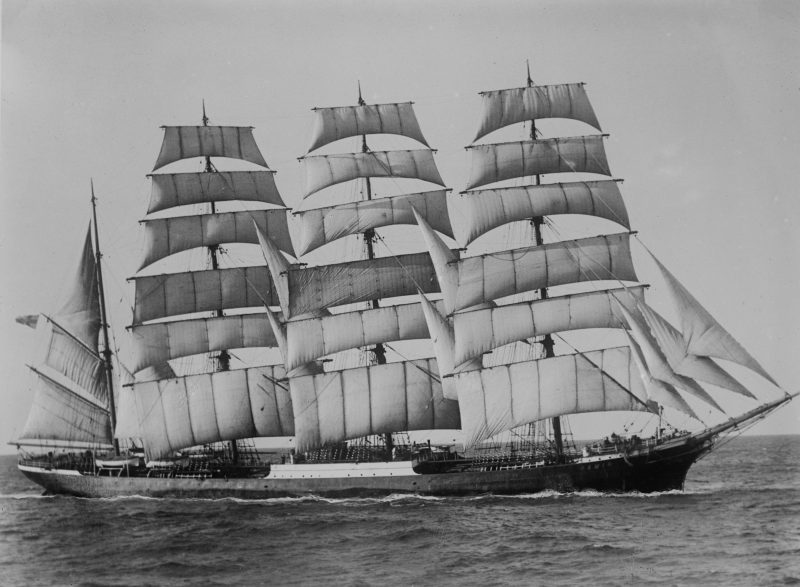Pamir, a four-masted barque, was one of the famous Flying P-Liner sailing ships of the German shipping company F. Laeisz. She was the last commercial sailing ship to round Cape Horn, in 1949. By 1957, she had been outmoded by modern bulk carriers and could not operate at a profit.
Her shipping consortium’s inability to finance much-needed repairs or to recruit sufficient sail-trained officers caused severe technical difficulties. On 21 September 1957 she was caught in Hurricane Carrie and sank off the Azores, with only six survivors rescued after an extensive search.
Pamir was built at the Blohm & Voss shipyards in Hamburg, launched on 29 July 1905. She had a steel hull and displacement of 3,020 GRT (2,777 net).
She had an overall length of 114.5 m (375 ft), a beam of about 14 m (46 ft) and a draught of 7.25 m (23.5 ft). Three masts stood 51.2 m (168 ft) above deck and the main yard was 28 m (92 ft) wide. She carried 3,800 m² (40,900 ft²) of sails and could reach a top speed of 16 knots (30 km/h). Her regular cruise speed was around 8-9 knots.
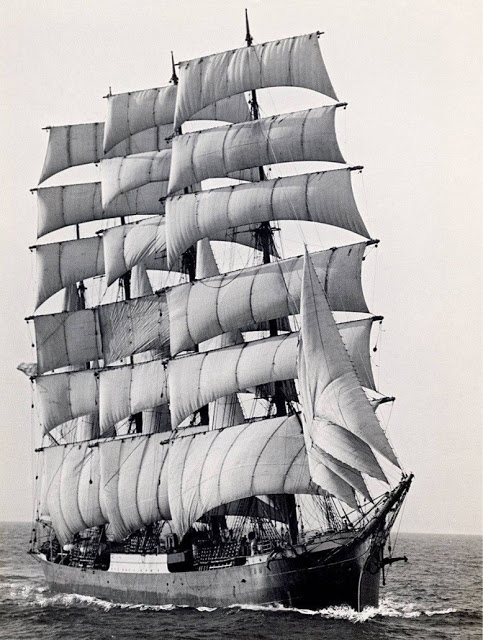
Pamir was the fifth of ten near-sister ships. She was commissioned on 18 October 1905 and used by the Laeisz company in the South American nitrate trade.
By 1914, she had made eight voyages to Chile, taking between 64 and about 70 days for a one-way trip from Hamburg to Valparaíso or Iquique, the foremost Chilean nitrate ports at the time. During World War I she stayed in Santa Cruz de la Palma port in La Palma Island, the Canary Islands between October 1914 until March 1920. Due to post-war conditions she did not return to Hamburg until 17 March 1920 from Santa Cruz de la Palma.
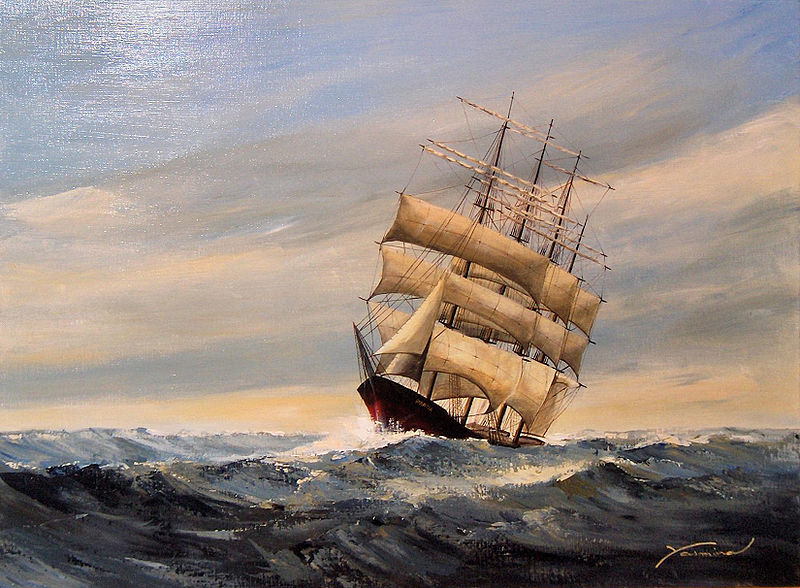
During World War II Pamir was seized as a prize of war by the New Zealand government on 3 August 1941 while in port at Wellington. Ten commercial voyages were made under the New Zealand flag: five to San Francisco, three to Vancouver, one to Sydney and her last voyage across the Tasman from Sydney to Wellington carrying 2700 tons of cement and 400 tons of nail wire. Weathering a storm during the last Tasman voyage is described in detail by one of the mates, Andrew Keyworth, in a letter never posted.
She escaped the war unscathed despite a close call in 1943 when a Japanese submarine was spotted. Evidently as a fast-moving barque under a strong and fair wind, she did not interest the submarine’s commander.
After the war she made one voyage from Wellington via Cape Horn to London, then Antwerp to Auckland and Wellington in 1948.
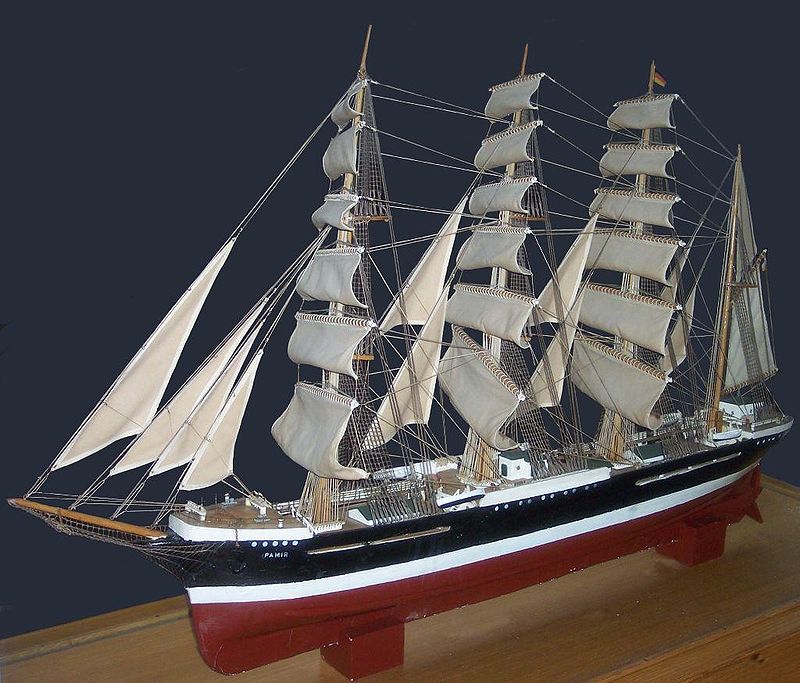
She was returned to the Erikson Line on 12 November 1948 at Wellington and sailed to Port Victoria on the Spencer Gulf to load Australian grain. On her 128-day journey to Falmouth, she was the last windjammer carrying a commercial load around Cape Horn, on 11 July 1949.
Due to ill health, her regular captain, Hermann Eggers, had been replaced by Captain Johannes Diebitsch, who had sailed on her as a young seaman and had commanded sail-training ships, but had little experience as master of cargo-carrying sailing ships.
His first officer, Rolf Köhler, was only 29 at the time and wrote that he was “getting thin with anger” over the state of the ship and that he was intending to quit the ship’s company after arriving home from the next voyage. Captain Diebitsch was criticized for being a harsh and inflexible officer.
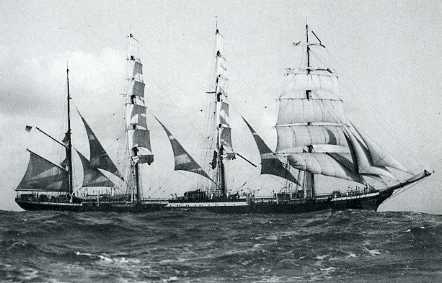
On 10 August 1957, she left Buenos Aires for Hamburg with a crew of 86, including 52 cadets. Her cargo of 3,780 tons of barley was stored loose in the holds and ballast tanks, secured by 255 tons in sacks on top of the loose grain.
Records indicate that this was one of the major mistakes implicated in the sinking – she had been held up by a dockworkers’ strike, and Diebitsch, under severe pressure to sail, decided to let the trimming (the correct storage of loose cargo so that it does not shift in the hold) be done by his own untrained crew. It was later found that he also had the ballast tank filled with barley.
Even though testing of the roll period (the time the ship took to right itself after load transfers) showed that she was dangerously unsafe, Diebitsch decided to sail.
On the morning of 21 September 1957, she was caught in Hurricane Carrie before shortening sails. It was later considered that because the radio officer had also been given substantial administrative tasks (to save the money required for another officer’s position), he had likely not received any of the radio storm warnings.
She had also not responded to radio hails by ships that had sighted her earlier in the voyage. She soon listed severely to port in the sudden storm. As hatchways and other openings were not closed at once, they probably allowed considerable amounts of water to enter, as found by the commission who examined the probable causes of the sinking.
The shipping company’s lawyer at the investigation claimed that the water entered her due to a leak. According to the commission, the water caused her to list further and the grain to shift, which aggravated the list.
A nine-day search for survivors was organized by the United States Coast Guard cutter USCGC Absecon (WAVP-374), but only four crewmen and two cadets were rescued alive, from two of the lifeboats.
It was reported that many of the 86 men aboard had managed to reach the boats, but most died in the next three days.As none of the officers nor the captain survived, the reasons for the capsizing remained uncertain.
The sinking made headlines around the world; it was a national tragedy in Germany.
